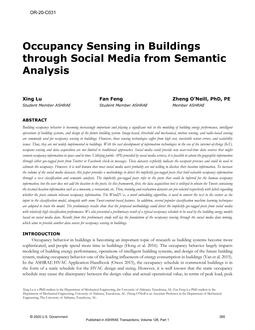
OR-20-C031 — Occupancy Sensing in Buildings through Social Media from Semantic Analysis
Click here to purchase
Building occupancy behavior is becoming increasingly important and playing a significant role in the modeling of building energy performance, intelligent operations of building systems, and design of the future building system. Image-based, threshold and mechanical, motion sensing, and radio-based sensing are commonly used for occupancy sensing in buildings. However, those sensing technologies suffer from high cost, inevitable sensor errors, and scalability issues. Thus, they are not widely implemented in buildings. With the vast development of information technologies in the era of the internet-of-things (IoT), occupant sensing and data acquisition are not limited to traditional approaches. Social media could provide new near-real-time data sources that might contain occupancy information in space and in time. Utilizing public APIs provided by social media services, it is possible to attain the geographic information through either geo-tagged posts from Twitter or Facebook check-in messages. These datasets explicitly indicate the occupant presence and could be used to estimate the occupancy. However, it is well known that most social media users probably are not willing to disclose their location information. To increase the volume of the social media datasets, this paper provides a methodology to detect the implicitly geo-tagged posts that hold valuable occupancy information through a text classification and semantic analysis. The implicitly geo-tagged posts refer to the posts that could be inferred for the human occupancy information, but the user does not add the location to the posts. In this framework, first, the data acquisition tool is utilized to obtain the Tweets containing the textual location information such as a museum, a restaurant, etc. Then, training and evaluation datasets are pre-selected respectively with labels regarding whether the posts contain relevant occupancy information. The Word2Vec, a word embedding algorithm, is used to convert the text to the vectors as the input to the classification model, alongside with some Tweet-content-based features. In addition, several popular classification machine learning techniques are adopted to train the model. The preliminary results show that the proposed methodology could detect the implicitly geo-tagged posts from social media with relatively high classification performance. We also presented a preliminary result of a typical occupancy schedule to be used by the building energy models based on social media data. Results from this preliminary study will lay the foundation of the occupancy sensing through the social media data mining, which aims to provide another data source for occupancy sensing in buildings.
Citation: 2020 Winter Conference, Orlando, FL Conference Papers
Product Details
- Published:
- 2020
- Number of Pages:
- 8
- Units of Measure:
- Dual
- File Size:
- 1 file , 1.7 MB
- Product Code(s):
- D-OR-20-C031


